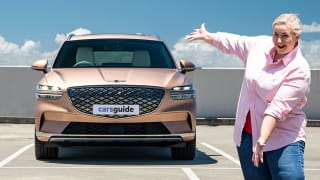To get started, we need to explain where the CX-60 is positioned in Mazda’s line-up. Despite looking quite large in pictures and in the metal, the CX-60 is still a mid-size SUV, and only marginally larger than the CX-5.
If you were hoping for a seven-seat offering, you’ll need to wait a little longer to hop into the incoming and even larger CX-80 and CX-90, but Mazda says the CX-60 is for buyers who are ready for something a little bigger and nicer feeling than the CX-5, but don’t need the extra seats.
This car also debuts a new large car rear-biased platform, a first for Mazda, with bigger engines and an overall more premium feel, one which the brand has been flirting with for some time.

Prices are decidedly premium to match. With a start price just shy of $60,000 for the base version, to nearly $90,000 for the top-grade, the CX-60 rivals only the most high-spec versions of rivals like the Mitsubishi Outlander, Toyota Kluger, and Hyundai Santa Fe, whilst dipping into the territory of luxury-badged rivals, like the Lexus NX, Genesis GV70, and even Audi Q5.
Thankfully, there’s a straightforward range of variants, which hasn’t always been the case for Mazda in the past.
The CX-60 is offered in three grades: The base Evolve, the mid-spec GT, and the top-spec Azami. Any of which can be chosen with one of three engine choices: The G40e inline-six turbo petrol, D50e inline-six turbo diesel, or P50e 2.5-litre four-cylinder plug-in hybrid.

With a luxury pricing structure comes a more or less premium set of standard equipment.
The base Evolve for example scores black synthetic ‘Maztex’ interior trim, 18-inch alloy wheels, LED headlights, a 10.25-inch multimedia screen and 7.0-inch digital dash both of which are upgradable to the dual 12.3-inch system on higher grades.
There’s also wireless phone mirroring, a wireless phone charger, built-in navigation, a 360-degree parking camera, dual-zone climate control, eight-way power seat adjust for the driver, and keyless entry with push-start ignition.

That’s right, no cloth seats or plastic steering wheels here, the CX-60 does stretch into premium territory, even on the base Evolve.
Next up, the GT grade nets you 20-inch alloy wheels, body coloured highlights, a driver monitoring system with facial recognition tech for automatic seat settings, a power tailgate, heated real leather seats front and rear with a heated steering wheel, electric adjust for the steering column, additional LED lighting for the interior, a panoramic sunroof and a premium audio system.
Finally, the top-spec Azami grade adds 20-inch wheels in an alternate design, adaptive LED headlights, Nappa leather interior trim, an even higher-grade adaptive cruise system, ventilated front seats, real leather door trim, additional lighting features, and more functions for the personalisation system.
Option packs include the Vision Tech package ($2000) which adds larger screens, premium cruise and driver monitoring systems, as well as a higher-grade 360-degree camera suite to the Evolve and GT grades, the Luxury package ($4000), which adds heated seats, real leather seat trim, and power seats with memory adjust to the base Evolve only.
Meanwhile, the top-spec Azami is offered with the choice of either the Takumi package ($2000), which adds white leather seat trim, bright interior inlays, and a cloth dash with maple wood highlights or the SP package ($2000) which includes tan leather interior trim with suede highlights, black 20-inch wheels in an alternate design, black exterior highlights, and a two-tone steering wheel.



































